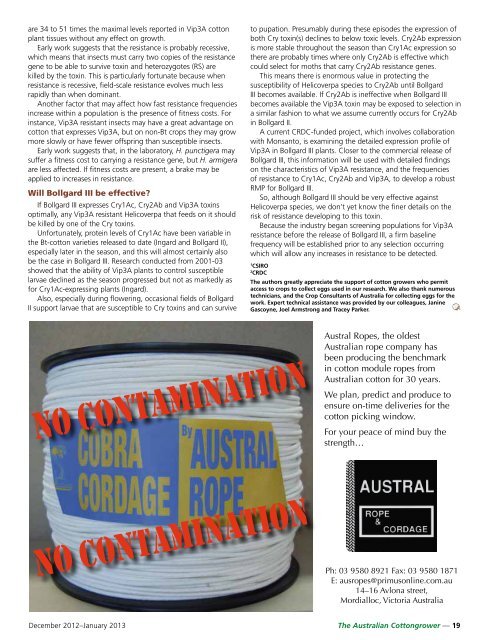cotton - Greenmount Press
cotton - Greenmount Press
cotton - Greenmount Press
Create successful ePaper yourself
Turn your PDF publications into a flip-book with our unique Google optimized e-Paper software.
are 34 to 51 times the maximal levels reported in Vip3A <strong>cotton</strong><br />
plant tissues without any effect on growth.<br />
Early work suggests that the resistance is probably recessive,<br />
which means that insects must carry two copies of the resistance<br />
gene to be able to survive toxin and heterozygotes (RS) are<br />
killed by the toxin. This is particularly fortunate because when<br />
resistance is recessive, field-scale resistance evolves much less<br />
rapidly than when dominant.<br />
Another factor that may affect how fast resistance frequencies<br />
increase within a population is the presence of fitness costs. For<br />
instance, Vip3A resistant insects may have a great advantage on<br />
<strong>cotton</strong> that expresses Vip3A, but on non-Bt crops they may grow<br />
more slowly or have fewer offspring than susceptible insects.<br />
Early work suggests that, in the laboratory, H. punctigera may<br />
suffer a fitness cost to carrying a resistance gene, but H. armigera<br />
are less affected. If fitness costs are present, a brake may be<br />
applied to increases in resistance.<br />
Will Bollgard III be effective<br />
If Bollgard III expresses Cry1Ac, Cry2Ab and Vip3A toxins<br />
optimally, any Vip3A resistant Helicoverpa that feeds on it should<br />
be killed by one of the Cry toxins.<br />
Unfortunately, protein levels of Cry1Ac have been variable in<br />
the Bt-<strong>cotton</strong> varieties released to date (Ingard and Bollgard II),<br />
especially later in the season, and this will almost certainly also<br />
be the case in Bollgard III. Research conducted from 2001-03<br />
showed that the ability of Vip3A plants to control susceptible<br />
larvae declined as the season progressed but not as markedly as<br />
for Cry1Ac-expressing plants (Ingard).<br />
Also, especially during flowering, occasional fields of Bollgard<br />
II support larvae that are susceptible to Cry toxins and can survive<br />
to pupation. Presumably during these episodes the expression of<br />
both Cry toxin(s) declines to below toxic levels. Cry2Ab expression<br />
is more stable throughout the season than Cry1Ac expression so<br />
there are probably times where only Cry2Ab is effective which<br />
could select for moths that carry Cry2Ab resistance genes.<br />
This means there is enormous value in protecting the<br />
susceptibility of Helicoverpa species to Cry2Ab until Bollgard<br />
III becomes available. If Cry2Ab is ineffective when Bollgard III<br />
becomes available the Vip3A toxin may be exposed to selection in<br />
a similar fashion to what we assume currently occurs for Cry2Ab<br />
in Bollgard II.<br />
A current CRDC-funded project, which involves collaboration<br />
with Monsanto, is examining the detailed expression profile of<br />
Vip3A in Bollgard III plants. Closer to the commercial release of<br />
Bollgard III, this information will be used with detailed findings<br />
on the characteristics of Vip3A resistance, and the frequencies<br />
of resistance to Cry1Ac, Cry2Ab and Vip3A, to develop a robust<br />
RMP for Bollgard III.<br />
So, although Bollgard III should be very effective against<br />
Helicoverpa species, we don’t yet know the finer details on the<br />
risk of resistance developing to this toxin.<br />
Because the industry began screening populations for Vip3A<br />
resistance before the release of Bollgard III, a firm baseline<br />
frequency will be established prior to any selection occurring<br />
which will allow any increases in resistance to be detected.<br />
1<br />
CSIRO<br />
2<br />
CRDC<br />
The authors greatly appreciate the support of <strong>cotton</strong> growers who permit<br />
access to crops to collect eggs used in our research. We also thank numerous<br />
technicians, and the Crop Consultants of Australia for collecting eggs for the<br />
work. Expert technical assistance was provided by our colleagues, Janine<br />
Gascoyne, Joel Armstrong and Tracey Parker.<br />
NO CONTAMINATION<br />
Austral Ropes, the oldest<br />
Australian rope company has<br />
been producing the benchmark<br />
in <strong>cotton</strong> module ropes from<br />
Australian <strong>cotton</strong> for 30 years.<br />
We plan, predict and produce to<br />
ensure on-time deliveries for the<br />
<strong>cotton</strong> picking window.<br />
For your peace of mind buy the<br />
strength…<br />
NO CONTAMINATION<br />
Ph: 03 9580 8921 Fax: 03 9580 1871<br />
E: ausropes@primusonline.com.au<br />
14–16 Avlona street, <br />
Mordialloc, Victoria Australia<br />
December 2012–January 2013 The Australian Cottongrower — 19

















